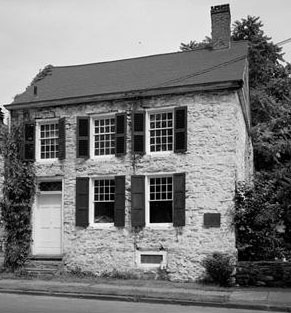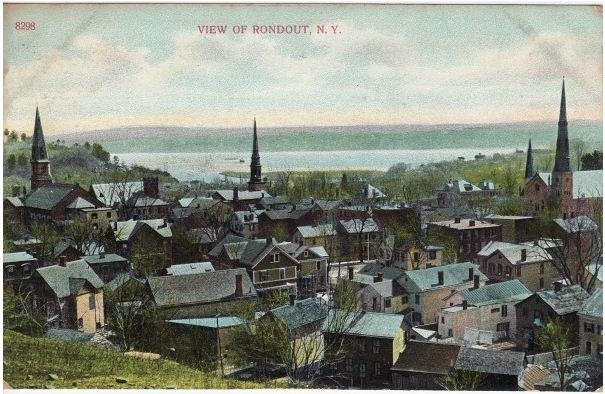
May 3, 1777
George Clinton, Brigadier General in the Continental Army and soon-to-be first Governor of New York, drafted a letter to the Provincial Convention of New York which, unbeknownst to him, helped seal the fate of Kingston during te t tumultuous year of 1777 in the American Revolution. The letter, in part, read, “The conduct of many of these traitors was so daring and insolent that a sudden and severe example seems to me absolutely necessary to deter others from the commission of like crimes.” The “conduct” mentioned was rallying New Yorkers to join the British in the fight against rebellious citizens who dared to take up arms against the King. The “sudden and severe example” that the Convention agreed upon was hanging the guilty parties from a gallows erected near where the current City Hall stands on Broadway in Kingston. The unfortunate men: Jacobus Rose, Jacob Middagh and seven other men Rose and Middagh enlisted to serve the King. Rose and Middagh were just two of many convicted of treason that May, 1777 at Fort Montgomery, in the Hudson Highlands, and sent to Kingston There they were sentenced to swing from the gallows by the neck until dead. Records indicate Rose and Middagh swung alone on May 13, 1777. Some of their counterparts were “recommended for mercy” and others were sent to prison instead. (A receipt dated May 13, 1777 of expenses paid for the execution names only Rose and Middagh as actually being hanged and shows the execution cost the state 11 pounds, 16 shillings). This little-known event took place five months before British General John Vaughan and his navy troops reached the mouth of the Esopus Creek, disembarked, then proceeded to burn the town to the ground.
Did the public executions of Rose and Middagh in Kingston have something to do with the total conflagration of this city by the British on October 16, 1777? Seems likely. Justifying his actions after the burning, General Vaughan is quoted in a letter to British Lieutenant- General Sir Henry Clinton describing Kinston as “a Town notorious for harbouring the most rebellious People in that Part of the Country.” It was no secret that at the time Kingston did not tolerate loyalty to the King and in fact, treated it harshly. Documents miraculously preserved from the time tell us so. It was also no secret that a radical new governing idea, a government for the PEOPLE, was being shaped in the back room of Abraham Van Gaasbeek’s house here in Kingston. And likewise, it was no secret that the
rebels were attempting to put into operation “one of the best constitutions and State governments that has ever been framed.” Talk about defiance. It is no wonder that in Vaughan’s opinion, the rebels in Kingston were provoking him.
Throughout the summer, all along the Hudson River towns were preparing for the worst. Provisions were being stored, government meetings were being held in secrecy, batteries of artillery were being erected and there was an overall feeling of great anxiety. At this time, George Clinton was elected Governor of the State of New York which brought about new responsibilities for the General. He was now responsible for raising troops to assist wherever needed in the state. There were not enough soldiers to cover areas most threatened, and to make matters worse, on August 1st , Albany appealed to New Englanders: “Is our Country to be laid waste, the Friends of America to be banished from their Homes, their all to be sacrificed at a Time when it is in our power (if we will Unite) to Crush the Invaders in such a manner that perhaps will prevent their making any future attempts?” On August 2nd, Clinton writes to General Ten Broeck, “Indeed every Man that can bear arms must on this Occasion be brought to the Field…” He clearly recognized the dangerous situation surrounding him and continually exerted every effort to ensure the safety of every corner of the state. But the British were on a roll, destroying towns, attacking forts and creating widespread panic all over New England, especially New York and the Hudson Valley.
The Hudson Valley had every reason to panic. A major force under British General John Vaughan was sweeping through the valley, claiming lives and victories at Fort Ticonderoga, Fort Schuyler, Fort Defiance and Oriskany. Skirmishes ensued around every corner. These American defeats prompted General Schuyler in Albany to write to Clinton in Kingston, “If Burgoyne gets to Albany, our State is gone in all its extent; for the people who would not turn out to prevent the enemy from penetrating will not be able to do it when they are got in.” This was obviously a difficult thing for the Governor of the state to digest. Clinton reacted by calling out more reinforcements from all over, including Vermont, Massachusetts and Connecticut. But the Council of Safety in New York remained panic-stricken and sent Clinton a less-than-uplifting letter stating that “In
this situation, Sir, nothing but our own exertions and the divine favor can extricate us…and if our Neighbors, if the Grand Army, if the whole Continent determine that our little mutilated state shall bear the weight of the American War…let us brave the Danger which they will not enable us to repel.” And brave the danger they did. The American forces held fast at every point, took their blows and after a few victories of their own, began to believe that this enemy was not invincible. In fact, after a major victory at Saratoga for the Americans in October, it was now time to consider calling in some assistance to strengthen the army, which came by way of France. With renewed vigor and help on the way, the Americans continued to fight and plot movements of troops to attempt to counter every attack the British tried to make.
So, what was Kingston the Capitol of New York doing during this chaotic time? As mentioned before, secret, defiant meetings to define and shape a new government were still being held in Van Gaasbeek’s house; Tories were still being tried, convicted and executed; men and women were busy gathering their belongings and preparing to flee an attack they feared was imminent. Forts Montgomery and Clinton, further down the river in the Hudson Highlands, were also bracing for an attack which came late in the day on October 6. Both forts were taken by the British, but not without a fight. According the British Commodore Hotham, “The loss on the Enemy’s side is not yet exactly known, but they are supposed to have had about 100 killed and 250 taken prisoners. The greatest Loss on the Side of the King’s Troops are about 40 killed, among whom are some valuable Officers…” According to Nathaniel Webb, and Officer of the Second New York Regiment, “There were not more than 600 men to defend ye two forts against near 3,000. The Americans were grossly outnumbered. Gouverneur Morris, defending the Americans who defended the forts wrote, “The Militia behaved as well as men could do. We shall beat them.” After the defeat in the Highlands, General Vaughan, who led the attacks, was confident he could continue on to assist General Burgoyne at Saratoga, who badly needed him at this point. But first Vaughan had a visit to pay.
Over a week later, on the morning of October 16, Vaughan’s fleet of British ships anchored just north of the mouth of the Esopus Creek. Claiming he was cannonaded by a breastworks just thrown up on shore in Ponckhockie, Vaughan ordered his troops to storm the town and lay it in ashes, which they did. Finally, the rebellious, defiant Captiol of New York would be silenced. Vaughan left Kingston the victor. Or was he? While proceeding up the Hudson with the lingering smell of smoke still in the air, Vaughan received word that Burgoyne was forced to surrender at Saratoga. This single victory was enough for the Americans to believe that suddenly this was a war they could win. It took 5 more long years and thousands of lives before the Americans could claim ultimate victory in the war and the states could become truly united. The radical idea of freedom and justice for all prevailed. And that defiant Captiol city that burned for its rebellious intentions was immediately rebuilt and today continues to be a reminder that the freedom we enjoy came at a tremendous price
(Photo: Vandenburgh-Hasbrouck House, Green Street, Kingston, New York)
